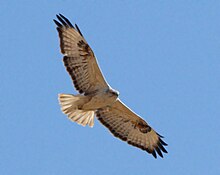Long-legged Buzzard
| Long-legged buzzard | |
|---|---|
 |
|
| Scientific classification | |
| Kingdom: | Animalia |
| Phylum: | Chordata |
| Class: | Aves |
| Order: | Falconiformes (or Accipitriformes, q.v.) |
| Family: | Accipitridae |
| Genus: | Buteo |
| Species: | B. rufinus |
| Binomial name | |
|
Buteo rufinus (Cretzschmar, 1829) |
|
 |
|
| Range of B. rufinus Breeding range Resident range Wintering range | |
| Synonyms | |
|
|
The long-legged buzzard (Buteo rufinus) is a bird of prey in the Buteo genus. It is similar in appearance to the rough-legged buzzard (Buteo lagopus), but it is larger and more robust.
This is one of the largest species of Buteo. Length can range from 50 to 66 cm (20 to 26 in) and wingspan from 115 to 160 cm (45 to 63 in). Females, at an average mass of 1.3 kg (2.9 lb), are larger than males, at an average of 1.1 kg (2.4 lb). There are many different colour forms, but usually long-leggeds have a clear orange tint to the plumage, red or orange tail, pale head and largely white underwings. There is usually a distinctive black carpal patch and dark trailing edge to the wing. The rump and "trousers" are often dark or deep rufous. Plumage varies from ghostly pale individuals to very dark ones. Some plumages are almost similar to those of the steppe buzzard, the eastern subspecies of the common buzzard (Buteo buteo vulpinus), but long-legged buzzards have longer wings and are more like rough-legged buzzards or even a small Aquila eagle.
It inhabits dry open plains of northern Africa, southeastern Europe, west and central Asia east to China, and across central India. Recent sightings indicate that there is a small population in the Apulian region of south-eastern Italy. Open, uncultivated areas, with high bushes, trees, cliffs or hillocks are favoured as nesting areas. Younger birds disperse north of breeding grounds and there are records from Northern Europe. The breeding population in Greece is around 60 pairs.
Reforestation in the Judean Mountains in Israel is displacing populations of the long-legged buzzard, and the species is moving into the Judean Foothills and competing with the short-toed snake eagle there.
It feeds mostly on small rodents, although it will also take lizards, snakes, small birds and large insects.
There are two subspecies recognised:
The North African subspecies has recently been recorded breeding in southern Spain.
...
Wikipedia

